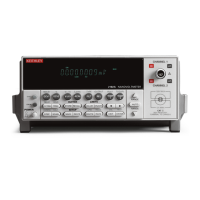C-2 Measurement Considerations
Measurement considerations
Low-level voltage measurements made using the Model 2182 can be adversely affected by
various types of noise or other unwanted signals that can make it very difficult to obtain accurate
voltage readings. Some of the phenomena that can cause unwanted noise include thermoelectric
effects (thermocouple action), source resistance noise, magnetic fields, and radio frequency
interference. The following paragraphs discuss the most important of these effects and ways to
minimize them.
NOTE For comprehensive information on low-level measurements, see the “Low Level
Measurements” handbook, which is available from Keithley.
Thermoelectric potentials
Thermoelectric potentials (thermal EMFs) are small electric potentials generated by
differences in temperature at the junction of dissimilar metals. The following paragraphs discuss
how such thermals are generated and ways to minimize their effects.
Thermoelectric coefficients
As shown in Table C-1, the magnitude of thermal EMFs generated depends on the particular
materials involved. Best results are obtained with clean copper-to-copper connections as
indicated in the table.
Table C-1
Table C-2Material thermoelectric coefficients
Material Thermoelectric Potential
Copper-Copper 0.2µV/°C
Copper-Silver 0.3µV/°C
Copper-Gold 0.3µV/°C
Copper-Cadmium/Tin 0.3µV/°C
Copper-Lead/Tin 1–3µV/°C
Copper-Kovar 40µV/°C
Copper-Silicon 400µV/°C
Copper-Copper Oxide 1000µV/°C

